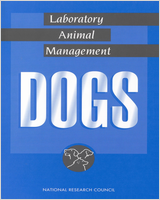Dogs make valuable contributions in biomedical research because they share many biochemical and physiologic characteristics with humans and spontaneously develop disorders that are homologous to pathologic conditions in humans. While using them as models for human disease, we have also learned much about normal physiologic processes in dogs themselves. Advances in molecular genetics, reproduction, behavior, immunology, hematology, endocrinology, microbiology, nutrition, pharmacology, and oncology, to name a few, have made dogs more valuable as models and, at the same time, have provided veterinarians with useful information for the diagnosis and treatment of canine diseases.
In the past 2 decades, two amendments to the Animal Welfare Act (in 1976 and 1985) and a section added to the Health Research Extension Act of 1985 have resulted in revised standards for dogs. Institutions that use dogs must comply with the Code of Federal Regulations, Title 9, Subchapter A, Parts 1–3 (9 CFR 1–3), commonly called the Animal Welfare Regulations (AWRs), which were promulgated to administer the Animal Welfare Act. Institutions receiving Public Health Service (PHS) funding must also comply with the Public Health Service Policy on Humane Care and Use of Laboratory Animals (hereafter called the PHS Policy) (PHS, 1986), which in turn requires compliance with the Guide for the Care and Use of Laboratory Animals (hereafter called the Guide) (NRC, 1985). Some of the AWRs are based on engineering standards (e.g., that on space requirements for dogs), but most rely on performance standards (i.e., the demonstration of animal well-being). It is expected, therefore, that professional judgment will be used in applying the AWRs. It is also incumbent on all people using dogs to seek improvements in the methods for using them.
This edition of Dogs: Laboratory Animal Management incorporates features of housing, management, and care that are related to the expanded use of dogs as models of human diseases and an interpretative summary of the AWRs and requirements of the PHS Policy. The appendix lists subjects within this text by page number with cross references to corresponding sections in the AWRs and the Guide. The regulations, policies, and guidelines that are applicable to dogs include the following:
- Code of Federal Regulations, Title 9, Subchapter A, Parts $1$2$3 (commonly called the Animal Welfare Regulations). Available from Regulatory Enforcement and Animal Care, APHIS, USDA, Federal Building, Room 565, 6505 Belcrest Road, Hyattsville, MD 20782 (telephone, 301-436-7833).
- Public Health Service Policy on Humane Care and Use of Laboratory Animals. Available in English or Spanish from the Office for Protection from Research Risks, Building 31, Room 5B59, NIH, Bethesda, MD 20892 (telephone, 301-496-7163).
- Guide for the Care and Use of Laboratory Animals. Available in English or Spanish from the Office for Protection from Research Risks, Building 31, Room 5B59, NIH, Bethesda, MD 20892 (telephone: 301-496-7163). Single copies (English only) available from the Institute of Laboratory Animal Resources, National Research Council, 2101 Constitution Avenue NW, Washington, DC 20418 (telephone, 202-334-2590).
- Code of Federal Regulations, Title 21, Part 58; Title 40, Part 160; and Title 40, Part 792 (commonly called the Good Laboratory Practice, or GLP, Standards). Available from the Superintendent of Documents, U.S. Government Printing Office, Washington, DC 20402 (telephone, 202-783-3238).
- IATA Live Animal Regulations. Available in English, French, or Spanish from the International Air Transport Association (IATA), 2000 Peel Street, Montreal, Quebec, Canada H3A 2R4 (telephone, 514-844-6311).
All animals used in research must be treated with the dignity and respect due living beings. Those who use animals in experiments must therefore be properly trained in methods appropriate for the species used. It is the responsibility of each research facility to develop educational programs for animal-care providers and the research staff (9 CFR 2.32). Recommendations for establishing such programs have recently been published (NRC, 1991).
References
- NRC (National Research Council), Institute of Laboratory Animal Resources, Committee on Care and Use of Laboratory Animals. 1985. Guide for the Care and Use of Laboratory Animals. NIH Pub. No. 86-23. Washington, D.C.: U.S. Department of Health and Human Services. 83 pp.
- NRC (National Research Council), Institute of Laboratory Animal Resources, Committee on Educational Programs in Laboratory Animal Science. 1991. Education and Training in the Care and Use of Laboratory Animals: A Guide for Developing Institutional Programs. Washington, D.C.: National Academy Press. 139 pp. [PubMed: 25144011]
- PHS (Public Health Service). 1986. Public Health Service Policy on Humane Care and Use of Laboratory Animals. Washington, D.C.: U.S. Department of Health and Human Services. 28 pp.
- PubMedLinks to PubMed
- Introduction - Laboratory Animal ManagementIntroduction - Laboratory Animal Management
Your browsing activity is empty.
Activity recording is turned off.
See more...
